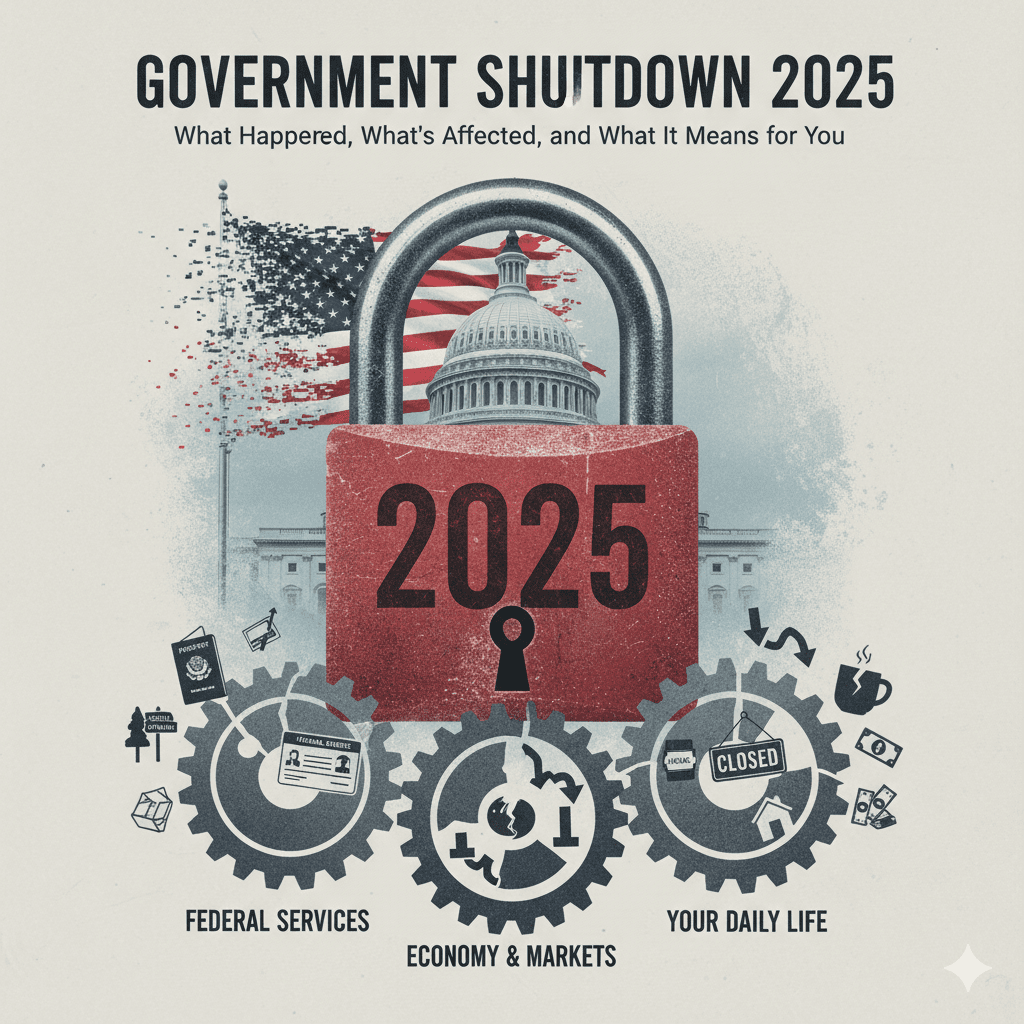Government shutdown 2025
On October 1, 2025, the United States federal government entered a partial shutdown after Congress failed to pass appropriations legislation or a continuing resolution before the fiscal-year deadline. The lapse in funding immediately forced many non-essential federal operations to pause, left hundreds of thousands of federal employees facing furloughs or unpaid work, and triggered cutbacks at key regulatory agencies and public services. Reuters+1
What exactly is a government shutdown?
A government shutdown happens when Congress does not pass the annual appropriation bills or a short-term continuing resolution to keep agencies funded. When funding lapses, agencies must stop activities that are discretionary and not legally authorized to continue without appropriations. Essential activities — generally those necessary to protect life and property, such as active military operations, air traffic control, and law enforcement — typically continue, while many programs and staff are furloughed. U.S. Representative Ami Bera
Why did this shutdown happen in 2025?
The 2025 shutdown resulted from a political impasse in Congress over spending levels and policy riders. Negotiations broke down when parties could not agree on whether to pair budget extensions with changes to health care subsidies and other policy demands. The Senate failed to advance measures that would have extended funding, and with the fiscal year starting October 1, discretionary appropriations lapsed. Both parties have blamed the other for the impasse. The Guardian+1
Is this a full or partial shutdown — who stays open?
Most reporting indicates the 2025 lapse is a partial shutdown: many departments continue essential operations, but large portions of government services will either slow or stop. For example, courts may scale back non-urgent functions, the Internal Revenue Service may delay certain services, and many regulatory agencies are reducing staff to skeleton crews. The Department of Defense and other truly essential services remain operational but may operate without pay for non-exempt staff until funding is restored. Reuters+1
What federal services will be affected?
Impact varies by agency, but common effects include:
Furloughs or unpaid leave for many civilian federal employees who perform non-essential work. News outlets estimate hundreds of thousands could be affected. CBS News
Regulatory slowdowns. Agencies like the SEC and CFTC are cutting staff dramatically, delaying IPO approvals, filings, and other market oversight tasks. That can slow business activity tied to federal approvals. Reuters
National parks and monuments. Many sites may reduce services or close visitor centers; some parks may remain open in a limited way (e.g., on-fee access), but interpretive services and maintenance are often suspended. CBS News
Grant programs, loan processing, and administrative services (like some small-business loans and civilian training programs) can be delayed or paused. The Washington Post
Will Social Security, Medicare, and veteran benefits stop?
Generally no. Mandatory programs — Social Security, Medicare, Medicaid, veterans’ benefits, and other entitlements funded by permanent law rather than annual appropriations — continue to operate and pay benefits. However, a shutdown can still slow administrative changes, new enrollments, or outreach services and can create confusion for recipients. U.S. Representative Ami Bera
Are the U.S. Postal Service and other independent agencies affected?
The U.S. Postal Service (USPS) is funded through postage and fees, not annual appropriations, so everyday mail delivery usually continues. Independent agencies funded by their own fees may keep operating, though some bodies that rely on annual appropriations will cut back. Regulatory bodies that depend on congressional appropriations may have reduced capacity. Reuters+1
Will federal workers get paid?
Federal employees classified as “excepted” (those necessary to protect life and property) remain on duty; many “non-excepted” employees will be furloughed. Historically, when shutdowns end, Congress has passed back pay for furloughed employees — but that is not guaranteed. The White House and agency managers will provide guidance on employee status, furlough numbers, and payroll expectations. CBS News+1
How long do shutdowns last — how long could this one last?
There’s no fixed duration — shutdowns have lasted from a single day to 35 days (the longest modern shutdown in late 2018–early 2019). How long the 2025 shutdown lasts depends on whether Congress and the White House reach a temporary funding deal or pass the necessary appropriations. Political dynamics, upcoming legislative calendars, and negotiations over policy riders will all affect timing. Reuters
Economic and market impacts to watch
Even a short shutdown can rattle markets and delay critical data releases. The 2025 shutdown led to cutbacks at financial regulators, which can stall IPOs and other market activity — investors often react immediately to such uncertainty. Economic data releases may be curtailed or delayed, which can increase volatility and complicate business planning. Reuters+1
Practical guidance: what you should do now
If you’re a federal employee: Check official agency communications (email, internal portals) for your status. Save emergency funds if possible; if furloughed, track guidance about back pay. Contact your union or human resources for specifics. CBS News
If you receive federal benefits: Continue to expect regular Social Security and Medicare payments, but stay alert for administrative updates. Keep records of any service disruptions. U.S. Representative Ami Bera
If you run or work for a business that depends on federal approvals: Anticipate delays (permits, loan processing, approvals) and adjust timelines and client expectations. Reuters
If you’re traveling to national parks or federal attractions: Check park and agency websites and local visitor centers for up-to-date access rules; some sites may remain open with reduced services. CBS News
How shutdowns are resolved
Usually Congress passes a continuing resolution (CR) that extends current funding levels or passes full appropriations bills. Alternatively, political compromise on disputed policy riders can remove barriers to passage. The White House and congressional leaders generally negotiate terms until a majority agrees to reopen funding. The timing and content of any agreement determine whether back pay is eventually authorized and which programs receive immediate funding. Reuters+1
Historical perspective and longest shutdown
The longest federal shutdown in modern history lasted 35 days from December 22, 2018, to January 25, 2019. Shutdowns have occurred many times in U.S. history, often varying greatly in scale and impact depending on which agencies and programs rely on annual appropriations. The 2025 shutdown is notable for its timing at the start of a fiscal year and for the scale of regulatory drawdowns being reported. The Washington Post+1





